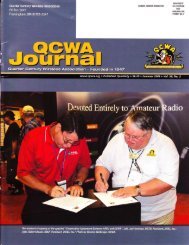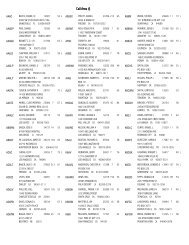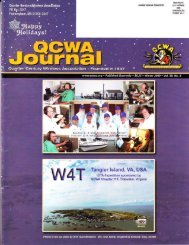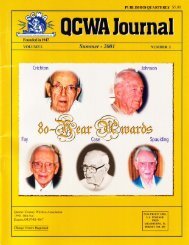Untitled - Quarter Century Wireless Association
Untitled - Quarter Century Wireless Association
Untitled - Quarter Century Wireless Association
You also want an ePaper? Increase the reach of your titles
YUMPU automatically turns print PDFs into web optimized ePapers that Google loves.
In 1944 Sgt. Given was selected to attend the Army's<br />
radio school in New York at the Brooklyn Army Base where she<br />
was to study commercial marine radio operating procedures'<br />
This 13 week assignment required the mastery of 45<br />
WPM plain text Morse code. The students were also required to<br />
copy blinker CW (Morse code sent by light between ships and<br />
ship-to-shore) at 13 WPM. Additionally, the WACS were<br />
required to service wet cell batteries and other radio equipment<br />
in lifeboats.<br />
The three most diffrcult problems confronting the<br />
WACs in the new schml environment were breaking the habit<br />
of the mind set for the rhythm of the code groups, unlearning<br />
the formerly learned military procedures and attaining the 45<br />
WPM code speed.<br />
Upon graduation, Esther Given was assigned to the<br />
USAHS Chateau Thierry. The *Chatty," as it came to be<br />
known, was a converted transport ship which was equipped to<br />
handle between 480-500 passengers, in addition to some 400<br />
crew of medical complement.<br />
After Esther and her two fellow WACs arrived onboard,<br />
the ship sailed from Charleston, South Carolina to<br />
Avonmouth, England in ear$ 1945. Adding a female twist to<br />
the name "Spark," which was associated with the GI radio<br />
operators, the WACs soon became known as "Sparkettes."<br />
For this first trip, two of the ship's former GI radio<br />
operators remained aboard to act in an advisory capacity to the<br />
WACs. The chief operator's first offrcial statement to the WACs<br />
was that a Spark stmd a four-hour watch regardless of mal de<br />
mer (seasickness) and that he, along with the other GI<br />
operators, were just accompanying the WACs for the ride on<br />
this trip. The WACs were expected to take over fully although<br />
the men would be there in case of dire emergency. Later, it was<br />
discovered that the two men had worked out a schedule between<br />
them so that they could stand a 24 hour watch when the<br />
experiment of women as radio operators failed.<br />
No indoctrination could have been more wicked than<br />
that oflanding on a newjob in entirely foreign surroundings as<br />
WAC operators with two strikes against trem, one of which was<br />
for being female and the other was the added feature of a North<br />
Atlantic storm brewing for the event. Nevertheless, much to the<br />
credit of the WACs, they proved to be equally capable with the<br />
men in these assignments.<br />
However, for this initial trip, the first two days were<br />
misery for the WACs on the "Chatty." One four-hour watch was<br />
an eon of sitting with cans (headphones) on the ears copying<br />
press at 30 WPM for the skipper's morning news with a bucket<br />
clamped tightty between the knees. By the second day<br />
something had to give. Because it could notbe the WAC guinea<br />
pigs, it had to be the bucket.<br />
Among duties of the radio operator aboard ship was to<br />
care for batteries and other emergency distress equipment in the<br />
lifeboats. According to Esther, probably the most tedious job for<br />
the WACs on hospital ships was this duty.<br />
On the *Chatty" two lifeboats contained such<br />
equipment. These lifeboats hung about 30 feet above the deck<br />
and had to be serviced each week. A long extension ladder was<br />
placed against the boom that ran parallel to the swinging<br />
QCWA Journal<br />
40<br />
lifeboats. The radio operator climbed to the top of the ladder,<br />
straddted the boom and waited until the lifeboat would swing<br />
near enough to jump in. All this time the operator was holding<br />
a can of distilled water and a hydrometer. The only change in<br />
the descent was that tlte water container and the hydrometer<br />
could be lowered to the deck by means of a rope.<br />
How€ver, the problem of getting back on the ladder<br />
was greater than that of getting into the boat. It didn't help<br />
matters that a full audience of ambulatory patients was on the<br />
deck below, gling advice and yelling "look out," or "wh@ps"<br />
at tense moments.<br />
Speaking of tense moments, Esther shared an<br />
interesting story of a very tense night. One night, homeward<br />
bound ofr the French coast, lit up like a Christmas tree, in<br />
compliance with the Geneva Treaty, carrytng 434 injured<br />
American GIs back home, the "Chatty" was challenged by a<br />
voice on a megaphone, coming out of the darkness,<br />
commanding the vessel to turn out all lights and stand by or be<br />
blown out of the water.<br />
Needless to say, the ship's lights were turned off and<br />
they stood by immediately. Unknowingly, the ship had sailed<br />
into the middle of a Canadian convoy bound for Europe and,<br />
when fully lighted, the ship's lights would have silhouetted the<br />
ships in the convoy to any lurking enemy.<br />
The next morning, when the sun arose, the hospital<br />
ship stood alone in the middle of the Atlantic with no sign of<br />
the hundreds of ships she had unknowingly jeopardized the<br />
night before.<br />
During W.W.[, radar was considered to be a weapon.<br />
However, incidents like this encounter convinced the military to<br />
install radar systems in all hospital ships after the war.<br />
As mentioned above, trafftc handled by a hospital ship<br />
during and immediately following W.W.[ was all in clear text.<br />
It chiefly concerned hydrographic position rq)orts, navigational<br />
reports, and incoming press (for the skipper, of course). No<br />
commercial messages were handled to or from the ship's<br />
personnel or patients aboard.<br />
Life aboard a hospital ship was not dull because the<br />
ship's mission was to care for the sick and injured. The ship<br />
carried the best supply of food afloat. Current movies were<br />
shovrn nightly. Additionally, Red Cross workers and chaplains<br />
prepared constant fun and entertainment for the patients and<br />
ship's complement.<br />
Another good feature of hospital ship life was that it<br />
returned to the states every month or two which meant a<br />
replenishment of rations, new movies and other stateside<br />
luxuries which many ships and personnel stationed overseas<br />
could not enjoy.<br />
Most patients were ambulatory. However, some were<br />
restricted to bed. In those cases, most of the ship's personnel<br />
made it a point to get acquainted, have a gabfest play cards, or<br />
do something with the folks who were bed patients below deck'<br />
One of Esther's favorite stories is as follows: After the<br />
war ended, the ship came into the lagooil at one stop at<br />
Ineweetok. The ship contacted the shore station in blit*er and<br />
after completion of the ship's business, the shore operator<br />
asked, "Are you a WAC?"


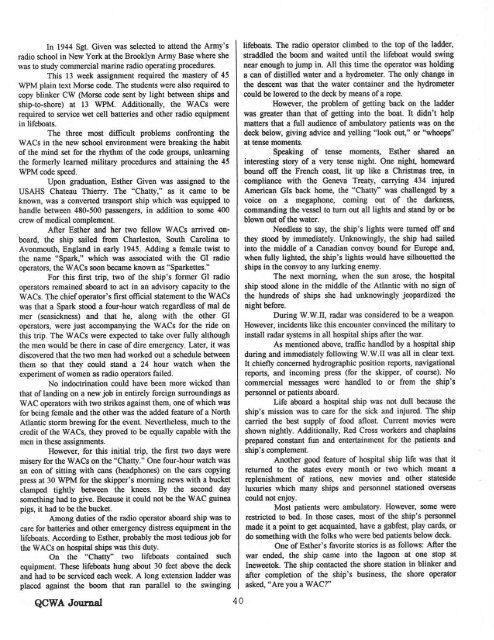

![11{J hI EfifSIt]E I]E - Quarter Century Wireless Association](https://img.yumpu.com/11816560/1/190x245/11j-hi-efifsite-ie-quarter-century-wireless-association.jpg?quality=85)
